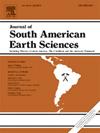Reconstructing Paleoproterozoic volcanic environments: Eruptive styles and evidence of phreatomagmatism in the Amazonian Craton's Colíder Group
IF 1.5
4区 地球科学
Q3 GEOSCIENCES, MULTIDISCIPLINARY
引用次数: 0
Abstract
Paleoproterozoic rocks are essential for understanding Earth's tectonic evolution, particularly in regions where juvenile crust and ore deposits formed. The Amazonian Craton features well-preserved Paleoproterozoic volcanic records, including age ranges linked to the Orocaima, Uatumã, and Colíder Silicic Large Igneous Provinces (SLIPs). Stratigraphic frameworks are supported by the description and interpretation of lithofacies. In the present work, we identify different eruptive styles (effusive and explosive) of the Colíder Group in the Alta Floresta Mineral Province. We have also described, for the first time in Alta Floresta Mineral Province, deposits associated with a phreatomagmatic eruption. The ancient volcanic successions comprises massive hypohyaline rhyolite lavas representing effusive dynamisms, with crystallization ages (U-Pb in zircon) around 1800 Ma, while lapilli tuff and tuffs represent explosive deposits with massive and stratified structures. The pyroclastic rocks compose an ignimbrite deposit. Four types of ash aggregates (ash pellets, coated ash pellets, accretionary lapilli, cored accretionary lapilli) suggest an origin associated with phreatomagmatic deposits. Additionally, epiclastic deposits are characterized by the reworking of primary volcanic rocks and basement rocks. These different eruptive styles allow us to reconstruct a paleoenvironment where water and magma interact during volcanic eruptions. This setting is typical in ancient and recent volcanic calderas, intra-caldera basins, or calderas where there is direct contact with seawater or riverine waters. Our discovery provides new data for the reconstruction of this Paleoproterozoic volcanic terrane and will be valuable for interpreting the geological evolution of this craton in the future.
重建古元古代火山环境:亚马逊克拉通Colíder群喷发样式和呼吸岩浆作用证据
古元古代岩石是了解地球构造演化的必要条件,特别是在早期地壳和矿床形成的地区。亚马逊克拉通具有保存完好的古元古代火山记录,包括与Orocaima, Uatumã和Colíder硅大火成岩省(slip)相关的年龄范围。岩相的描述和解释支持了地层格架。在本工作中,我们确定了Alta Floresta矿产省Colíder群的不同喷发风格(喷涌型和爆发性)。我们还首次在阿尔塔弗洛雷斯塔矿产省描述了与一次呼吸岩浆喷发有关的矿床。古火山序列由块状低透明流纹岩熔岩组成,代表了喷流动力学,结晶年龄(锆石中的U-Pb)在1800 Ma左右,而珠光凝灰岩和凝灰岩则代表了具有块状和分层结构的爆炸矿床。火山碎屑岩构成了一个火成岩矿床。四种类型的灰分聚集体(灰分球团、包覆灰分球团、增生石粒、芯状增生石粒)表明其成因与呼吸岩浆沉积有关。此外,表碎屑沉积以原生火山岩和基岩的改造为特征。这些不同的喷发风格使我们能够重建火山喷发时水和岩浆相互作用的古环境。这种环境在古代和近代的火山口、火山口内盆地或与海水或河水直接接触的火山口中是典型的。这一发现为该古元古代火山地体的重建提供了新的资料,对今后解释该克拉通的地质演化具有重要意义。
本文章由计算机程序翻译,如有差异,请以英文原文为准。
求助全文
约1分钟内获得全文
求助全文
来源期刊

Journal of South American Earth Sciences
地学-地球科学综合
CiteScore
3.70
自引率
22.20%
发文量
364
审稿时长
6-12 weeks
期刊介绍:
Papers must have a regional appeal and should present work of more than local significance. Research papers dealing with the regional geology of South American cratons and mobile belts, within the following research fields:
-Economic geology, metallogenesis and hydrocarbon genesis and reservoirs.
-Geophysics, geochemistry, volcanology, igneous and metamorphic petrology.
-Tectonics, neo- and seismotectonics and geodynamic modeling.
-Geomorphology, geological hazards, environmental geology, climate change in America and Antarctica, and soil research.
-Stratigraphy, sedimentology, structure and basin evolution.
-Paleontology, paleoecology, paleoclimatology and Quaternary geology.
New developments in already established regional projects and new initiatives dealing with the geology of the continent will be summarized and presented on a regular basis. Short notes, discussions, book reviews and conference and workshop reports will also be included when relevant.
 求助内容:
求助内容: 应助结果提醒方式:
应助结果提醒方式:


